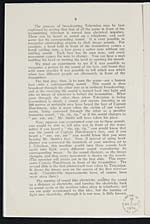John Logie Baird (1888-1946)
Television: a popular talk
2
The process of broadcasting Television may be best
explained by stating that first of all the scene in front of the
transmitting televisor is turned into electrical impulses.
These can be heard as sound on a telephone, and each
scene has its corresponding sound. It is even possible to
recognize outstanding objects by their image sounds. For
example, a hand held in front of the transmitter causes a
harsh rattling note, a face gives a softer note without any
rattling sound. Each face has its own note, and every
movement causes the note to change. You can hear a man
nodding his head or turning his head or opening his mouth.
We tried an experiment to see if it was possible to
recognize a person by the sound of his face, and found that
with some practice it was possible to tell which was which
when two different people sat alternately in front of the
transmitter.
The first step, then, is to turn the scene—say a human
face—into a corresponding sound. This sound is then
broadcast through the ether just as in ordinary broadcasting,
and at the receiving the sound is turned back into light and
into an image of whatever is before the transmitter. What
goes through the ether then when Television is being
transmitted is simply a sound, and anyone listening in on
200 metres at midnight may have heard the face of Captain
Hutchinson, who is most often the victim of our experi-
ments, being conveyed through the ether as a peculiar
humming sound, “rip, rip, rip,” or if the sound changes to
“zur, zur, zur,” Mr. Smith will have taken his place.
Now, suppose you accustomed your ear to these sounds,
you would be able to tell who was in front of the trans-
mitter if you heard a “rip, rip, rip,” you would know that
was the sound of Captain Hutchinson's face, and if you
heard a “zur, zur, zur ” you would know that you were
hearing Mr. Smith's face. Now, if instead of using head-
phones you connected the terminals of your wireless set to
a Televisor, this machine would turn these sounds back
again into light, every different sound reproducing its
corresponding image. As the sound changes, so the image
changes, and thus every movement is shown on the screen.
(The operator will please put in the first slide. This repre-
sents Captain Hutchinson in front of the transmitter. The
second slide is the first photograph ever taken bv Television.
It shows the image seen on the screen of the first televisor
made. Considerable improvements have, of course, been
made since then.)
The turning of sound into electricity, sending the sound
to a distance as electricity, and turning the electricity back
to sound again at the receiver takes place in telephonv, and
we are quite accustomed to this idea, but the turning of
light into electricity, although it is not new, is little known,
[NLS note: a graphic appears here – see image of page]


